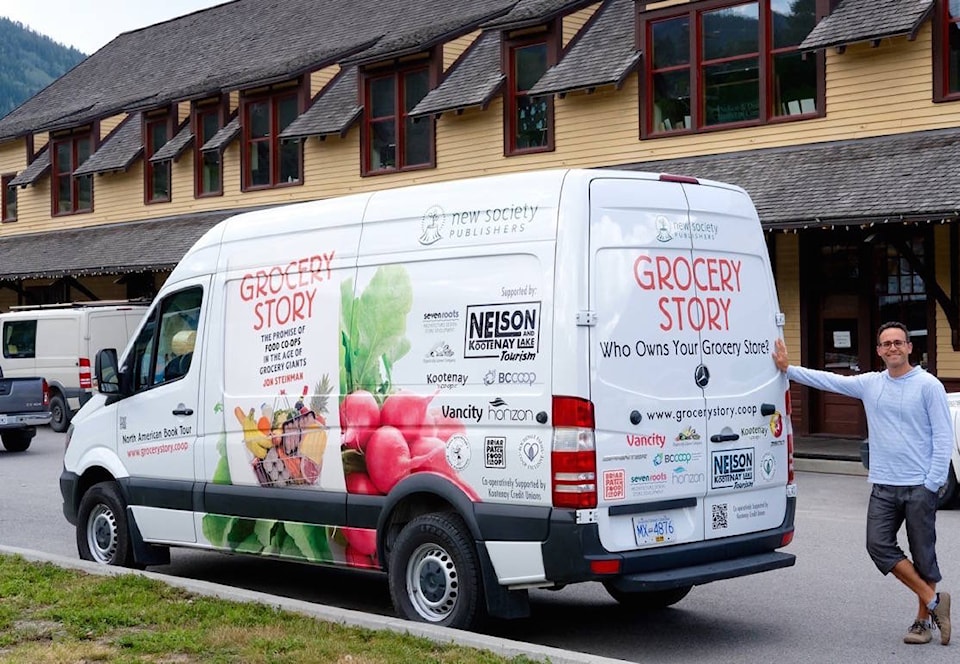Nelson’s Jon Steinman has just returned from the first half a very unusual book tour.
He’s the author of Grocery Story: the Promise of Food Co-ops in the Age of Grocery Giants published this year by New Society Publishers.
“The book peels back the curtain on how the big grocery stores in our country operate,” Steinman says. “Most grocery stores in this area are owned by Sobeys, the Jim Pattison Group, or Loblaws. Those three companies own almost every grocery store in this province.”
Steinman says five companies receive over 80 per cent of Canadians’ grocery dollars. Loblaws and Sobeys account for more than 50 per cent.
“What that means is these companies, because there are fewer and fewer options for food producers to sell to, have that much more power to dictate terms to their suppliers. There are examples of small manufacturers having to pay fees to get their product into the store to begin with.”
He has just toured the book to 50 food co-ops in the eastern U.S., giving talks and media interviews along the way.
The second leg of his tour begins in Creston, Kaslo, Vernon, Grand Forks, and Vancouver in September, and then heads for about 70 co-ops in the western U.S. This trip will include presentations to university and college classes in sustainable agriculture and the economics of food systems.
Steinman says his book is unique.
“No one has written a book in North America about how the grocery stores influence the food system, particularly their methods of controlling the buyer-supplier relationship, and what tools they use.
“We know a lot about the Monsantos and Coca-Colas and McDonalds of the world, but what about the Loblaws and the Krogers?”
Deconstructing Dinner
Steinman produced and hosted the Nelson-based syndicated radio show and podcast Deconstructing Dinner. He wrote and hosted Deconstructing Dinner: Reconstructing our Food System, a television and web series currently streaming online. He produces the annual Deconstructing Dinner Film Festival in Nelson and was an elected director of the Kootenay Co-op from 2006 to 2016, serving as president from 2014 to 2016.
Not every author can afford such an extensive tour in a graphically designed van.
Steinman’s trip is supported by a long list of food co-ops including the Kootenay Co-op, and by, among others, Nelson Kootenay Lake Tourism, VanCity Credit Union, the B.C. Co-operative Association, and the Nelson and District Credit Union. He also ran an extensive crowdfunding campaign.
“And the co-ops are feeding me wherever I go,” he says.
Owning your grocery store
Food co-ops are Steinman’s answer to the corporate domination of our grocery lives.
“We have the choice of handing our food dollars over to one of three massive companies not located near us,” he says, “or we can keep it circulating through our community at a co-op. The co-op model allows shoppers to be part owners of the store.”
Steinman says there are about 300 food co-ops in the U.S. and about 15 in Canada. Another 100 are in various stages of development. Some don’t have a retail store at all. But overall, Steinman thinks they are more influential than people realize.
“What co-ops have been doing for the past 45 years is seeding all the changes we are seeing in the dominant grocery sector right now, whether it be reducing plastic use, increasing bulk sections, or increasing organic and fair trade food. Co-ops have been doing this kind of thing since the 1970s.”
Meeting members’ needs
Co-operatives (which include credit unions) differ from other businesses in several key ways.
Their stated purpose is to meet the common needs of their members, not the financial needs of shareholders. Co-operatives and credit unions use the one member/one vote system, not the one vote per share system used by most businesses.
Co-operatives share profits among their member-owners based on how much they contribute to the co-op, not on how many shares they hold. One of their guiding principles is to invest their profits in improving service to their members and the well-being of their communities.
The Kootenays: a hotbed of co-ops
According to the Upper Columbia Co-op Council there are over 40 incorporated co-operatives in the Kootenay Boundary, including credit unions, food co-ops, radio stations, artisans’ co-ops, land co-ops, housing co-ops, social service co-ops and carshare services that all do business cooperatively.
Co-op directors and employees made up much of Steinman’s audience on the tour. He says many have become so focused on the task at hand that they forgot the significance of their role as co-op leaders.
“Their biggest take-away from my talks is realizing they forgot how important co-ops are to their communities and to the food system, and for some people it was realizing it for the first time.”
‘But it’s too expensive’
As a veteran advocate for co-ops, Steinman says is he often confronted with the concern that food co-op groceries are too expensive.
“There is both truth and myth to that,” he says.
If co-op food is more expensive (which often it is not, he says), it may be because “co-ops are trying to perpetuate a fair food system so the people producing and manufacturing food are paid fairly and the people who work on the farms and factories are paid fairly. That leaves us with a choice of what kind of future we want to invest in. But it might be that we cannot afford to eat that way.
“To those people, I say don’t be hard on yourself. We are all just doing our best to figure out how to afford food that aligns with our values and I hope with this book to plant some more information for people so over time they can make more informed decisions.”
This story was altered on Aug. 21 to correct the details in paragraph three about grocery store ownership.
